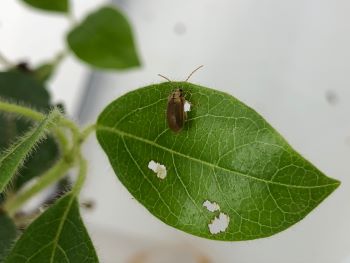Viburnum Leaf Beetle Project
Project Leader: Gaylord Desurmont
Presentation & context
The viburnum leaf beetle (VLB) Pyrrhalta viburni (Paykull) (Coleoptera: Chrysomelidae) is an invasive pest of plants belonging to the genus Viburnum (Adoxaceae). It is native to Eurasia and invasive in North America where it defoliates native and ornamental viburnum plants in natural areas and managed landscapes. There are about 20 Viburnum species native to North America and most of them are susceptible to the beetle: the most susceptible species can be killed after 2 to 4 years of repeated defoliations (Weston et al. 2007). This pest also indirectly impacts the fauna that rely on viburnum fruits as a food source, such as overwintering songbirds. A recent six-year study in Pennsylvania showed that VLB invasion negatively affected the local avian community in terms of overall bird diversity and winter mass gain (Smith and Hatch 2017). In its native range, VLB mainly occurs on the three most common Eurasian viburnums: V. opulus, V. lantana, and V. tinus, and is considered an occasional pest (Balachowsky 1963).

Damage caused by the viburnum leaf beetle young larvae on Viburnum tinus in the field
(photo: Gaylord Desurmont)
A: Viburnum leaf beetle larva (photo: Gaylord Desurmont)
B: Viburnum leaf beetle adult (photo: Gaylord Desurmont)
Research components
Because VLB infests shrubs in natural habitats where chemical control is impossible and in managed landscapes where chemical control using broad-spectrum insecticides is often not desired due to potentially harmful environmental consequences, classical biological control would be a very desirable management option for this emerging pest. A number of natural enemies of VLB have been described in the literature (Zorin 1931, de V. Graham 1985, Cox 1994), with one egg parasitoid belonging to the genus Aprostocetus (Hymenoptera: Eulophidae) reaching up to 35% parasitism locally (Zorin 1931). The native range of VLB covers most of Eurasia, and the geographical origin of the population that invaded North America is currently unknown. In order to develop a successful classical biological control program, the focus will be initially placed on the following priorities: 1) determining the geographical origin of invasive VLB populations, 2) exploring the assemblage of natural enemies of VLB in its native range, particularly in the area of origin of the invasive population(s), and 3) investigating the ecology, impact, and specificity of these parasitoids. Finally, some recent behavioral data have shown that VLB adults are attracted by odors of infested VLB twigs in an olfactometer setting: identifying these odors could potentially lead to the creation of attractive lures that could be used to monitor and/or manage VLB in its invasive range.
Egg parasitoids of the viburnum leaf beetle collected in Europe (photo: Gaylord Desurmont)
References
Balachowsky, A. 1963. Entomology applied to agriculture. Tome I. Coleoptera. Second volume. Entomology applied to agriculture. Tome I. Coleoptera.
Cox, M. L. 1994. The Hymenoptera and Diptera parasitoids of chrysomelidae, pp. 419-467, Novel aspects of the biology of Chrysomelidae. Springer.
de V. Graham, M. 1985. Tetrastichus species (Hymenoptera, Eulophidae), parasitizing the elm-leaf beetle Pyrrhalta luteola (Müll.) and allied hosts. Journal of natural history 19: 1059-1071.
Smith, R. J., and M. I. Hatch. 2017. Loss of Southern Arrowwoods (Viburnum dentatum) Is Associated With Changes In Species Composition and Mass Gain By Spring Migrants Using Early Successional Habitat. The Wilson Journal of Ornithology 129: 247-258.
Weston, P. A., G. Desurmont, and R. E. Hoebeke. 2007. Viburnum leaf beetle (Coleoptera: Chrysomelidae): biology, invasion history in North America, and management options. American Entomologist 53: 96-112.
Zorin, P. 1931. Guelder rose leaf-beetle (Galerucella viburni Payk.). Bull. Inst. Controlling Pests Dis 1: 55-79.

